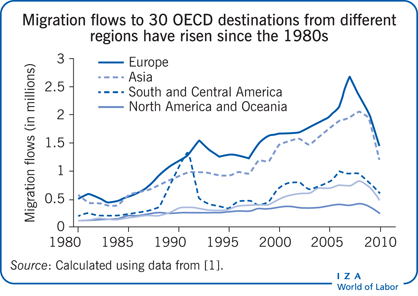Elevator pitch
As migration flows to developed countries have increased in recent decades, so have the number of countries from which migrants arrive. Thus, it is increasingly important to consider what role differences in culture and language play in migration decisions. Recent work shows that culture and language may explain migration patterns to developed countries even better than traditional economic variables, such as income per capita and unemployment rates in destination and origin countries. Differences in culture and language may create barriers that prevent the full realization of the potential economic gains from international mobility.

Key findings
Pros
Self-selection to more culturally similar destination countries boosts returns to human capital and improves integration.
Large communities of people with the same language and culture in destination countries encourage moves and decrease migration costs.
Acquiring skills in the language of the destination country is a human capital investment, even for temporary migrants.
Knowing the most widely spoken languages (in particular, English) provides an additional advantage to migrants.
Historical ties (especially when colonial languages are also an official language in the origin country) lower migration costs.
Cons
If migrants respond to linguistic and cultural barriers in some countries by migrating to countries with closer cultural ties to their country of origin, they may miss out on larger economic gains elsewhere.
Restrictive migration and naturalization policies that include a premium for knowledge of local languages increase selection.
Linguistic and cultural enclaves may reduce the return to skills.
Cultural enclaves may marginalize migrants by reducing socio-economic assimilation.
It is difficult to measure fluency in second languages and understand their role in migration decisions.